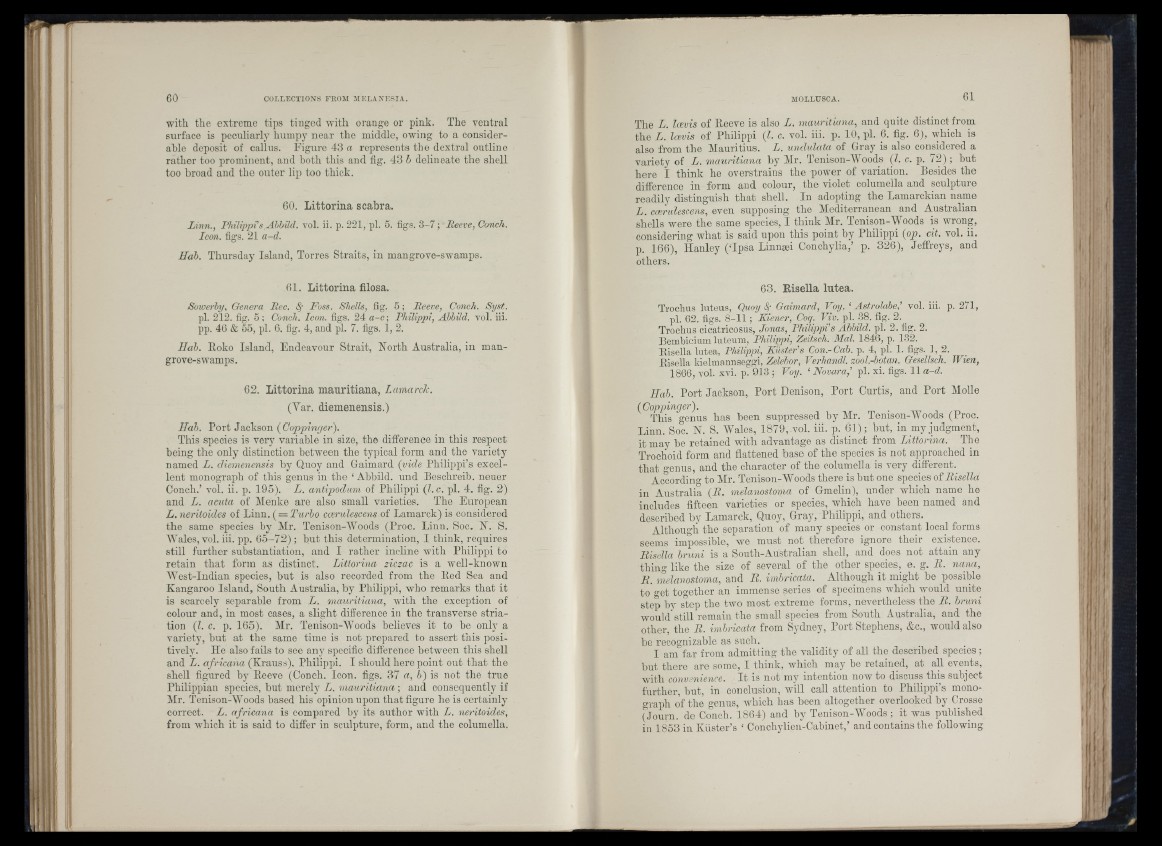
with the extreme tips tinged with pink. The ventral
surface is peculiarly humpy near the middle, owing to a considerable
deposit of callus. Figure 43 a represents the dextral outline
rather too prominent, and both this and lig. 43 h delineate the shell
too broad and the outer lip too thick.
60. Littorina scahra.
Linn., rhiJippHs Ahhild. vol. ii. p. 221, pi. 5. figs. 3 -7 ; Reeve, Conch.
Icon. figs. 21 a-d.
Hah. Thursday Island, Torres Straits, in mangrove-swamps.
The L. Icevis of Reeve is also L. mauritiana, and quite distinct from
the L. lævis of Philippi { I c. vol. iii. p. 10, pi. 6. fig. 6), which is
also from the Mauritius. L. undulata of Gray is also considered a
variety of L. mauritiana by Mr. Tenison-AA*oods (?. c. p. 72) ; hut
here I think he overstrains the power of variation. Besides the
difference in form and colour, the violet columella and sculpture
readily distinguish th at shell. In adopting the Lamarckian name
L. coeridesceiis, even supposing the Mediterranean and Australian
shells were the same species, I think Mr. Tenison-AAtoods is wrong,
considering what is said upon this point by Philippi (op. cit. vol. ii.
p. 166), Hanley (‘Ipsa Linnæi Conchylia,’ p. 326), Jeffreys, and
others.
It ;
61. Littorina iilosa.
Sowerhy, Genera Rec. 4' Foss. Shells, fig. 5; Reeve, Conch. Syst.
pi. 212. fig. 5 ; Conch. Icon. figs. 24 a-c; riulippi, Ahhild. vol. iii.
pp. 46 & 55, pi. 6. fig. 4, aud pi. 7. figs. 1, 2.
IIah. Roko Island, Endeavour Strait, North Australia, in mangrove
swamps.
62. Littorina mauritiana, Lamardc.
(Ator. diemenensis.)
Hah. Port Jackson (Coppinyexj.
This species is very variable in size, the difference in this respect
being the only distinction bctAveen the typical form and the variety
named L. diemenensis by Qnoy and Gaimard {vide Philippi’s excellent
monograph of this genus iu the ‘ Ahhild. und Beschreib. neuer
Conch.’ vol. ii. p. 195). L. antipodmxi of Philippi (/. c. pi. 4. fig. 2)
and L. acuta of Menke are also small varieties. The European
L. xieritoides of Linn. ( = Tuxho cceralescens of Lamarck) is considered
the same species by Mr. Tenison-AA^’oods (Proc. Linn. Soc. N. S.
AVales, vol. iii. pp. 6 5 -7 2 ); hut this determination, I think, requires
still further substantiation, and I rather incline with Philippi to
retain th at form as distinct. Littox-ixia ziczac is a well-known
AA’est-Iudian species, hut is also recorded from the Red Sea and
Kangaroo Island, South Australia, by Philippi, who remarks th at it
is scarcely separable from L. maux-itiana, with the exception of
colour and, in most cases, a slight difference in the transverse stria-
tion (I. c. p. 165). Mr. Tenison-AAtoods believes it to be only a
variety, but at the same time is not prepared to assert this positively.
He also fails to see any specific difference between this shell
and L. afx-icana (Krauss), Philippi. I should here point out th at the
shell figured by Reeve (Conch. Icon. figs. 37 a, b) is not the true
Philippian species, but merely L. mauritiana.; and consequently if
Mr. Tenison-AA'oods based his opinion upon th at figure he is certainly
correct. L. afxlcaxia is compared by its author with L. nex-itoides,
from which it is said to differ in sculpture, form, and the columella.
63. Risella lutea.
Trocbus luteus, Quoy V Gaimard, loy. ‘ Astroluhe,’ vol. iii. p. 271,
pi. 62. figs. 8-11 ; Kiener, Coq. Viv. pi. 38. fig. 2. _
Trocbus cicatricosLis, Jonas, Rhilipprs Ahhild. pi. 2. fig. 2.
Bemhicium luteum, Philippi, Zeitsch. Mai. 1846, p. 132.
Risella lutea, Philippi, Küster’s Con.-Cah. p. 4, pi. 1. figs. 1,2.
Risella kielmaniiseggi, Zelehor, Vex-handl. zool.-hotan. Gesellsch. Wien,
Í 866, vol. xvi. p. 913 ; Voy. ‘ Novara,’ pi. xi. figs. 11 a-d.
ITab. Port Jackson, Port Denison, Port Curtis, and Port Molle
(Ooppixiger).
This genus has been suppressed by Mr. Tenison-AAtoods (Proc.
Linn. Soc. N. S. AVales, 1879, vol. iii. p. 61); but, in my judgment,
it may be retained with advantage as distinct from Littox-ina. The
Trochoid form and flattened base of the species is not approached in
th at genus, and the character of the columella is very different.
Accordino- to Mr. Tenison-AVoods there is but one species oí Risella
in Australia (i?, melaxiostoma of Gmelin), under which name ho
includes fifteen varieties or species, which have been named and
described by Lamarck, Qnoy, Gray, Philippi, and others.
Although the separation of many species or constant local forms
seems impossible, we must not therefore ignore their existence.
Risella bruni is a South-Australian shell, and does not attain any
thing like the size of several of the other species, e. g. li. naxia,
Ii. melaxiostoma, and R. ixnbricata. Although it might be possible
to get together an immense series of specimens which would unite
step by step the two most extreme forms, nevertheless the Ii. hx'uni
would'still remain the small species from South Australia, aud the
other, the li. imhx-icata from Sydney, Port Stephens, &c., would also
be recognizable as such.
I am far from admitting the validity of all the described species;
but there are some, I think, which may be retained, at all events,
with conveniexice. I t is not my intention now to discuss this subject
further, but, in conclusion, will call attention to Philippi’s monograph
of the genus, ivhich has been altogether overlooked by Crosse
rjourn. de Conch. 1864) and by Tenison-AAteods ; it was published
in 1853 in Kiister’s ‘ Conchylieu'-Cabinet,’ and contains the following
: i